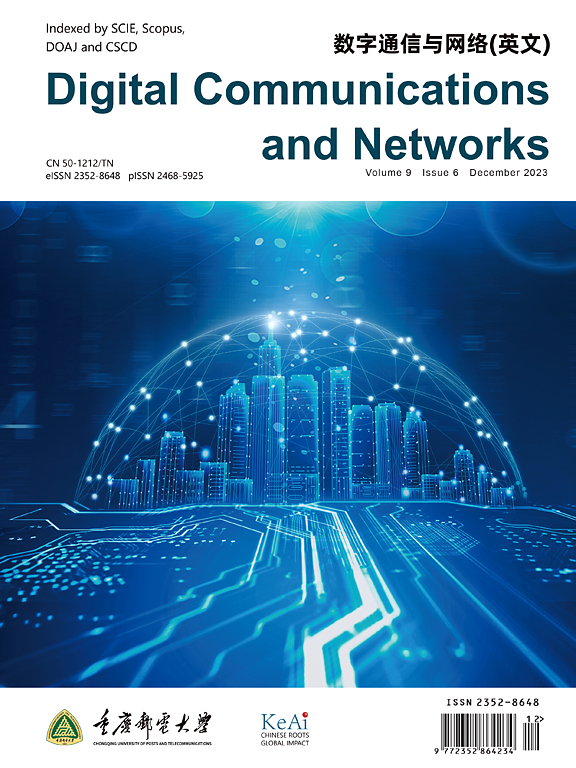可信工作证明:分布式物联网网络的轻量级区块链共识
IF 7.5
2区 计算机科学
Q1 TELECOMMUNICATIONS
引用次数: 0
摘要
传统的物联网(IoT)架构依赖集中式服务器进行数据管理和决策,容易受到安全威胁和隐私泄露。为了解决这个问题,区块链一直提倡以防篡改、可追踪和透明的方式进行分散的数据管理。然而,阻碍区块链与物联网融合的一个主要问题在于,对于资源受限的物联网设备来说,执行工作量证明(PoW)等计算密集型区块链共识是相当具有挑战性的。此外,PoW的激励机制推动轻量级物联网节点聚集其计算能力,以增加成功生成区块的可能性。然而,这最终导致了计算能力联盟的形成,并严重损害了区块链辅助物联网(BC-IoT)网络的去中心化和安全性。为了解决这些问题,我们提出了一种轻量级的BC-IoT共识协议,称为可信工作证明(pow)。提议共识的目标是抑制计算能力的集中化,并鼓励轻量级物联网节点独立参与区块链共识。首先,我们提出了链上声誉评估规则和pow声誉链,根据节点对区块链共识的计算能力贡献,实现节点声誉的可验证性和可追溯性,并将多级块生成难度作为节点积累声誉的奖励。其次,对pow的区块生成过程进行建模,并利用连续时间马尔可夫链分析区块吞吐量。此外,我们定义并优化了相对吞吐量增益,以量化和最大化PoTW抑制计算能力集中化(即集中化抑制)的能力。此外,我们还研究了算力联盟的算力和区块生成难度对pow中心化抑制能力的影响。最后,仿真结果证明了分析结果在块吞吐量方面的一致性。特别是,结果表明,与PoW相比,PoTW有效地降低了计算能力联盟的块生成比例,同时提高了单个轻量级节点的生成比例。这说明PoTW能够在一定程度上抑制计算能力的集中化。此外,随着区块生成难度等级的增加,PoTW的中心化抑制能力增强。本文章由计算机程序翻译,如有差异,请以英文原文为准。
Proof-of-trusted-work: A lightweight blockchain consensus for decentralized IoT networks
Traditional Internet of Things (IoT) architectures that rely on centralized servers for data management and decision-making are vulnerable to security threats and privacy leakage. To address this issue, blockchain has been advocated for decentralized data management in a tamper-resistance, traceable, and transparent manner. However, a major issue that hinders the integration of blockchain and IoT lies in that, it is rather challenging for resource-constrained IoT devices to perform computation-intensive blockchain consensuses such as Proof-of-Work (PoW). Furthermore, the incentive mechanism of PoW pushes lightweight IoT nodes to aggregate their computing power to increase the possibility of successful block generation. Nevertheless, this eventually leads to the formation of computing power alliances, and significantly compromises the decentralization and security of BlockChain-aided IoT (BC-IoT) networks. To cope with these issues, we propose a lightweight consensus protocol for BC-IoT, called Proof-of-Trusted-Work (PoTW). The goal of the proposed consensus is to disincentivize the centralization of computing power and encourage the independent participation of lightweight IoT nodes in blockchain consensus. First, we put forth an on-chain reputation evaluation rule and a reputation chain for PoTW to enable the verifiability and traceability of nodes' reputations based on their contributions of computing power to the blockchain consensus, and we incorporate the multi-level block generation difficulty as a rewards for nodes to accumulate reputations. Second, we model the block generation process of PoTW and analyze the block throughput using the continuous time Markov chain. Additionally, we define and optimize the relative throughput gain to quantify and maximize the capability of PoTW that suppresses the computing power centralization (i.e., centralization suppression). Furthermore, we investigate the impact of the computing power of the computing power alliance and the levels of block generation difficulty on the centralization suppression capability of PoTW. Finally, simulation results demonstrate the consistency of the analytical results in terms of block throughput. In particular, the results show that PoTW effectively reduces the block generation proportion of the computing power alliance compared with PoW, while simultaneously improving that of individual lightweight nodes. This indicates that PoTW is capable of suppressing the centralization of computing power to a certain degree. Moreover, as the levels of block generation difficulty in PoTW increase, its centralization suppression capability strengthens.
求助全文
通过发布文献求助,成功后即可免费获取论文全文。
去求助
来源期刊

Digital Communications and Networks
Computer Science-Hardware and Architecture
CiteScore
12.80
自引率
5.10%
发文量
915
审稿时长
30 weeks
期刊介绍:
Digital Communications and Networks is a prestigious journal that emphasizes on communication systems and networks. We publish only top-notch original articles and authoritative reviews, which undergo rigorous peer-review. We are proud to announce that all our articles are fully Open Access and can be accessed on ScienceDirect. Our journal is recognized and indexed by eminent databases such as the Science Citation Index Expanded (SCIE) and Scopus.
In addition to regular articles, we may also consider exceptional conference papers that have been significantly expanded. Furthermore, we periodically release special issues that focus on specific aspects of the field.
In conclusion, Digital Communications and Networks is a leading journal that guarantees exceptional quality and accessibility for researchers and scholars in the field of communication systems and networks.
 求助内容:
求助内容: 应助结果提醒方式:
应助结果提醒方式:


